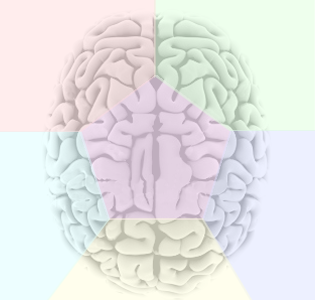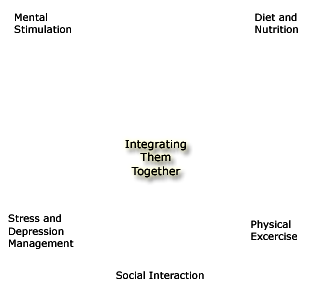Another Reason to Exercise
Note: This is not an official Alzheimer’s Association publication. It was compiled for information purposes only. If you have a concern regarding your health, or what to take or do for any mental or physical ailment you should consult with a licensed physician
Before we get into exercise – in last month’s review we noted the importance of fish, fish oil and omega -3 fatty acids, specifically DHA, for reducing the risk of AD (Alzheimer’s disease) and other dementias. Since then I’ve found additional studies supporting that find. But of interest to vegetarians, and any with the APOE-4 Alzheimer’s gene, I also found buried in the Chicago fish study this interesting note:
“Intake of alpha-linolenic [oils] was strongly protective among persons with the APOE-4 allele, but there was no apparent association among persons who were E-4 negative.”(1)
What are some sources for linolenic oils? Flax seed, walnuts, canola oil, kiwi fruit, wheat germ, soybeans, spinach, avacados, almonds and strawberries. This study suggests those with the APOE-4 “Alzheimer’s gene” may benefit from these. Now on to exercise –
In the Maintain Your Brain class developed by the Alzheimer’s Association, from the research they have sponsored and collected, we note four physical problems which studies has shown contribute to dementia. They are: Obesity, diabetes, high blood pressure, and high LDL low HDL cholesterol. All of these contribute to “heart” or cardio-vascular disease” and accordingly may contribute to Alzheimer’s. (One mantra of this program is – “whatever is bad for the heart is bad for the brain”) and there is one simple, free remedy which has been shown to be helpful in significantly reducing or controlling each of these, and that is physical exercise.
Perhaps it is for this reason, as well as others, that Dr. Ronald Petersen, of the Alzheimer’s Research Center at the Mayo Clinic has noted: “Regular physical exercise is probably the best means we have of preventing Alzheimer’s disease today. There are other possible interventions including diet, supplements, intellectual activities, and medications, but data indicates that physical activity is the most likely to prevent the disease.”
From the Journal of the American Medical Association September 2004 we learn that “older men who walked less than one-quarter mile each day had nearly twice the risk of dementia as men who walked more than two miles.”(2) Data are from more than 2,000 participants in the Honolulu-Asia Aging Study.
In a similar study at UCLA involving 6000 women, they found that the more miles a woman walked on a daily basis, the lower her risk of becoming demented. For each daily extra mile there was a 13 % improvement in memory compared to women who walked less.(3)
What type of exercise is best?
In a study of 3,375 men and women older than 65, those who engaged in four or more different types of leisure physical activity had about the half the risk of dementia of those who engaged in one or none. In this study the variety of activities seemed to have the protective effect. The 15 types of activities considered in the study included walking, household chores, mowing, raking, gardening, hiking, golfing, swimming and dancing.(4)
How hard and often do we need to exercise to have this protective effect?
One study of 18,000 nurses 30 to 55 years old, found those who engage in moderate exercise, including walking at an easy pace for 30 minutes five days a week, scored better on cognitive tests than those who exercised less.(5)
A study of 1,449 older adults shows those who in middle age exercised vigorously enough to perspire and breathe hard for 20 to 30 minutes at least twice a week reduced their risk of later developing Alzheimer’s disease by about 60 percent.(6)
Dr. Zamrini from the Center for Alzheimer’s Care, Imaging and Research, at the University of Utah suggests to his patients, at least 30 minutes of exercise 3 or more times a week. And this doesn’t have to be all at once he notes. It could be two 15 minute activities or three 10 minute sets, but the time starts once a person is breathing harder than normal. And as the studies suggest, the more often and the more consistent we are the better. Plus exercising in the sun provides the added benefit of Vitamin D, a powerful antioxidant for the brain. And remember to drink plenty of water, as this is also believed to be an essential element for healthy sustained brain function.
Were never too young to start but…
While exercise throughout our life is important and predictive, a 5 year Canadian study involving 4615 elderly men and women over the age of 65 again discovered that people who did more exercise were less likely to develop Alzheimer’s disease. “Those with the highest level or regular physical activity had cut their likelihood of having cognitive impairment or dementia in half.” (7)
Another study at Oregon Health and Science University found that even those in their 70’s and 80’s, “who exercised vigorously,” over a period of several years were able to lower their risk of developing dementia. (8)
However, it’s important not to delay this important activity. In a more sobering note Neuropsychiatrist Yonas Geda of the Mayo Clinic in a large survey of 900 people (ages 70-89), found that although exercise habits at ages 50-60 were correlated with the development of dementia – the more often they exercised, the less likely they were to develop the disease, “the exercise habit a year prior to the interview was NOT protective against MCI (Mild Cognitive Impairment).” A lifelong commitment to regular exercise is most likely to protect the brain.
But even those with dementia appear to benefit from exercise. In one study funded in part by the National Institute on Aging (NIA) involving “older adults with dementia or cognitive impairment,” those who were engage in programs involving such physical activities as walking, strength and flexibility training, or mild aerobic exercise were found to benefit not only in terms of physical fitness, but cognitive function and behavior as well.(9)
In fact there is currently a study going in the Brain Builder’s program at the Intermountain LDS hospital in Salt Lake City examining the added benefits of exercise for diagnosed individuals over the age of 65, on medication for dementia. And preliminary results suggest the combination of aerobic, strength and flexibility exercises appears to be helping. In fact if you know of someone in the Salt Lake area who meets this criteria, you are invited to refer them to this study. Just call the hospital and ask for the Brain Builder’s program in the Neuropsych department.
Why is exercise so helpful?
At the first of this review I noted it’s value in reducing a variety of cardio and brain risk factors, but additionally of course exercise helps to improve the circulation of vital oxygen and other nutrients to the brain. We may be on a healthy diet, but if our body can’t get those needed nutrients to the brain, sooner or later we’re going to develop problems. Additionally we know that exercise can improve digestion, and help to reduce stress and depression, which over time can be harmful to the brain. In fact exercise has been shown to be as powerful as prescription anti-depressants in preventing and overcoming depression.(10)
But even more directly, studies with mice suggest that physical exercise lowers the level of plaques and helps the body produce nerve growth factor and other substance which actually help stimulate the generation of new brain cells. (11)
Finally, a note from the now famous Kungsholmen study presented at the Alzheimer’s Association 9th International Conference on Alzheimer’s Disease and Related Disorders, in Philadelphia, in of 2004. While physical exercise in and of itself can be very helpful. It’s of value to note that while activities involving physical, mental and social stimulation all seem to offer protection against developing dementia “activities that combine all three kinds of stimulation offer the greatest benefit.”(12) So let’s find a friend and go get some exercise while the sun shines! Other research shows those who exercise with a friend are much more likely to continue. And of course it appears that’s what we need to do if we are to maintain our brain.
David R. Larsen, MFHD Alzheimer’s Association of Utah
References
- 1.Morris MC, Evans DA, Bienias JL, et al. Consumption of fish and omega-3 fatty acids and risk of incident Alzheimer disease. Arch Neurol. 2003 Jul;60(7):940-6.
- Abbott, Robert D.; White Lon R.; and others “Walking and dementia in physically capable elderly men.” JAMA Sept. 22/29, 2004; 292 (12); 1447-1453.
- K. Yaffe et. al., “A prospective study of physical activity and cognitive decline in elderly women: women who walk,” Archives of Internal Medicine 161 (14): 1703-1708 (2001)
- Podewils, Laura Jean; Guallar, Eliseo; Lyketsos, Constantine G.; et al. “Physical Activity, APOE Genotype, and Dementia Risk: Findings from the Cardiovascular Health Cognition Study.” American Journal of Epidemiology April 1, 2005; 161: 1 – 13.
- Weuve, Jennifer K.; Kang, Jae Hee; Manson, J.E.; Breteler, Monique M.; Ware, J.H.; and Grodstein, Francine. “Physical Activity, Including Walking, and Cognitive Function in Women.” JAMA Sept. 22/29, 2004; 292 (12): 1454 – 1461.
- Rovio, Suvi; Kareholt, Ingemar; Helkala, Eeva-Liisa; Viitanen, Matti; Winblad, Bengt; Tuomilehto, Jaakko; Soininen, Hilkka; Nissinen, Aulikki; and Kivipelto, Miia. “Leisure-time physical activity at midlife and the risk of dementia and Alzheimer’s disease.” The Lancet Neurology; published online Oct. 4, 2005.
- Reported in M Fotuhi, MD, PhD.s “The Memory Cure,” McGraw Hill, 2003, p. 111.
- D. K. Friedman et. al., “Use it or Lose it: A prospective evaluation of intellectual activity and the development of dementia,” Neurology 58 (S3): A103 (2002).
- Heyn, Patricia; Abreu, Beatriz; and Ottenbacher, Kenneth. “The Effects of Exercise Training on Elderly Persons With Cognitive Impairment and Dementia: A Meta-Analysis.” Archives of Physical Medicine and Rehabilitation October 2004; 85: 1694 – 1704.
- Neil Nedley, M.D. “Depression the Way Out.” Nedley Publishing 2005.
- Van Praag, Henriette; Shubert, Tiffany; Zhao, Chunmei; and Gage, Fred H. “Exercise Enhances Learning and Hippocampal Neurogenesis in Aged Mice.” Journal of Neuroscience Sept. 21, 2005; 25(38): 8680 – 8685.
- Karp, Anita; Paillard-Borg, Stephanie; Wang, Hui-Xin; Silverstein, Merrill; Winblad, Bengt; and Fratiglioni, Laura. “Mental, Physical and Social Components in Common Leisure Activities in Old Age in Relation to Dementia: Findings from the Kungsholmen Project.” Abstract published in Neurobiology of Aging, July 2004, Vol. 25, S2: p. S313.
Prevention Strategies 








- FREE SPECIAL REPORT AND UPDATES
For free monthly updates on the latest practical research related to brain health and memory improvement, and a free 23 page report on How to Prevent or Arrest Alzheimer's, Click here. Recent Comments
Archives
- July 2019
- November 2018
- September 2018
- July 2018
- June 2018
- April 2018
- February 2018
- January 2018
- December 2017
- October 2017
- September 2017
- August 2017
- June 2017
- May 2017
- March 2017
- January 2017
- December 2016
- October 2016
- September 2016
- August 2016
- June 2016
- May 2016
- April 2016
- March 2016
- February 2016
- January 2016
- December 2015
- November 2015
- August 2015
- July 2015
- June 2015
- May 2015
- April 2015
- March 2015
- February 2015
- January 2015
- November 2014
- October 2014
- September 2014
- August 2014
- July 2014
- June 2014
- April 2014
- March 2014
- February 2014
- January 2014
- December 2013
- November 2013
- October 2013
- September 2013
- August 2013
- July 2013
- June 2013
- June 2012
- February 2012
- January 2012





